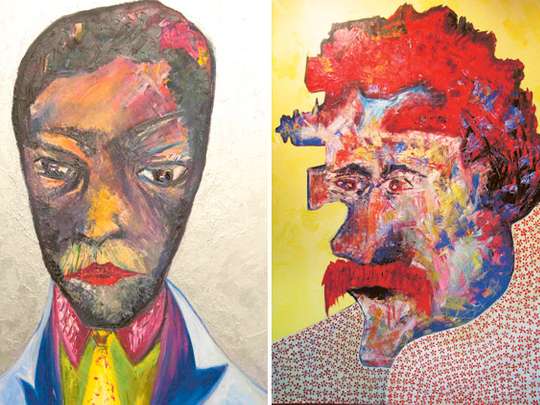
Hamid Iravani loves to paint human faces. However, rather than depicting how people look on the outside, the distorted features and exaggerated expressions on these faces reveal how they are feeling inside. The Iranian American artist’s latest exhibition, titled “My Good, Bad and Ugly Faces”, features a series of colourful oil and acrylic paintings that explore the conflicts and dualities that we all struggle with in our daily lives.
Iravani is an Urban Design consultant by profession and specialises in transportation planning and developing mathematical travel demand forecast models. He paints only in his spare time. Thus, the divided, conflicted faces in his paintings are essentially a representation of the duality that exists in his own life. “As an urban planner, I am deeply concerned that modern cities are being shaped by traffic-engineering standards. The highways and wide roads in cities are designed with cars in mind, not pedestrians. My paintings reflect this conflict between art and mathematical models, between traffic-engineering standards and the human element. And they give me the opportunity to express myself with freedom, without rules or constraints,” he says.
The faces that Iravani paints are not based on specific people, but drawn from his imagination. “I have always been fascinated by how just a few elements — a nose, a mouth, two eyes and two eyebrows — can come together to generate billions of different faces. I love to challenge myself to draw different faces and have notebooks filled with thousands of drawings. At school and university I would draw faces when I was bored during class and even now I find myself doing that during business meetings that go off on a tangent. It just happens spontaneously, and I have no idea what face will emerge at the end,” he says.
Although the basic drawing is done almost subconsciously, the artist carefully plans the colours and composition, adding various details inside the faces to tell different stories. His paintings reflect his perceptions about the people he meets, the events happening around him and the books he reads. A face full of pain and covered with tears of blood expresses his feelings about the civil strife in the region. While another one is calm and immersed in an ocean of soothing blue, representing the dreamer in all of us. One painting has been done in the style of the graffiti that he saw on the streets of Vienna on a recent trip. And another, with toys painted inside the face, alludes to the child that is inside us all.
In many paintings Iravani has depicted men dressed in suits and ties. But the emphasis is on their expressions, which are sad, angry, tired and confused. In some of these artworks the artist has embellished the clothes with beads and sequins to highlight the difference between the shiny exterior and the contrary emotions raging below the surface. “These are salesmen, bureaucrats and other professionals, who have to project a smart, confident exterior, but behind that façade, they are overworked, stressed out and unsure of themselves. Their distorted and split faces reflect this duality between their public and private selves and the harsh realities of the world we are living in,” Iravani says.
Some of the paintings have been inspired by the words of Iravani’s favourite authors and poets such as Franz Kafka, Jelaluddin Rumi and Sa’adi Shirazi. There is a painting of Gregor Samsa, from Kafka’s “The Metamorphosis”, showing him as a monstrous bug. But inside the savage face the artist has painted a clubhouse and trees to represent the tragic character’s dreams of escaping from the situation in which he is trapped. Similarly, a painting of a woman with her eyes covered, but perhaps looking inwards at many faces inside her head, is Iravani’s interpretation of Rumi’s well-known words — “Close both eyes to see with the other eye”.
The message that Iravani wants to convey through his art is that regardless of where we come from, what we do or what we look like, all human beings are the same. This is beautifully expressed in a set of eight small paintings, showing different faces. When placed together in a certain order, one can see that the paintings are connected. “This work was inspired by Sa’adi’s words — ‘Human beings are members of a whole, in creation of one essence and soul, if one member is afflicted with pain, other members uneasy will remain’,” the artist says.
“My paintings reflect my own moods. Often I stop working on a painting and complete it another day to capture a variety of different moods in one piece. I want to show the good, bad and ugly facets of our personality and the insanity that exists within all of us beneath the sane front that we put on for the world to see. I do not need to look at a particular person to draw my faces, because I do not paint the surface. I paint attributes, attitudes and emotions that are hidden behind every face. Each one of the faces I paint is me. And I hope that viewers will also see some aspect of themselves in every face,” he adds.
Jyoti Kalsi is an arts enthusiast based in Dubai.
“My Good, Bad and Ugly Faces” will run at Centroid Gallery, Dubai Knowledge Village, until May 31.


